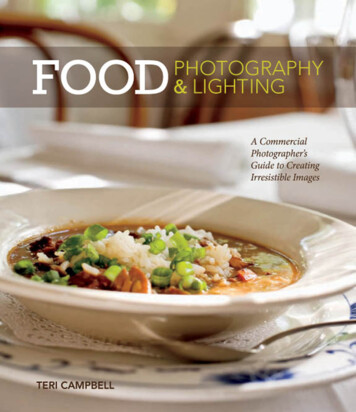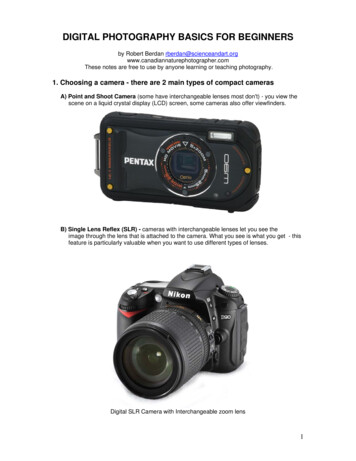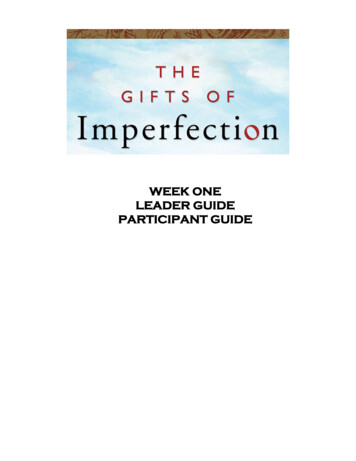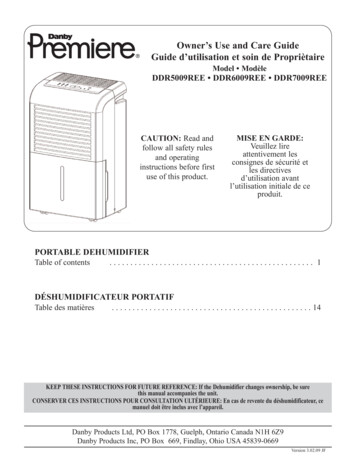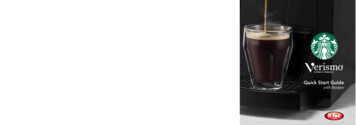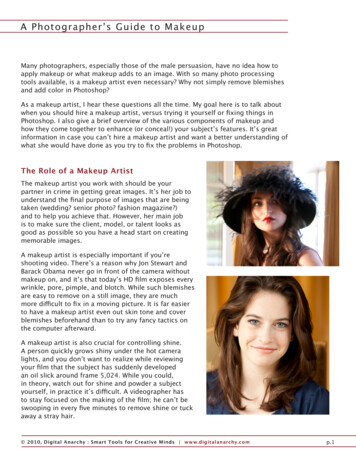
Transcription
A Photographer’s Guide to MakeupMany photographers, especially those of the male persuasion, have no idea how toapply makeup or what makeup adds to an image. With so many photo processingtools available, is a makeup artist even necessary? Why not simply remove blemishesand add color in Photoshop?As a makeup artist, I hear these questions all the time. My goal here is to talk aboutwhen you should hire a makeup artist, versus trying it yourself or fixing things inPhotoshop. I also give a brief overview of the various components of makeup andhow they come together to enhance (or conceal!) your subject’s features. It’s greatinformation in case you can’t hire a makeup artist and want a better understanding ofwhat she would have done as you try to fix the problems in Photoshop.The Role of a Makeup ArtistThe makeup artist you work with should be yourpartner in crime in getting great images. It’s her job tounderstand the final purpose of images that are beingtaken (wedding? senior photo? fashion magazine?)and to help you achieve that. However, her main jobis to make sure the client, model, or talent looks asgood as possible so you have a head start on creatingmemorable images.A makeup artist is especially important if you’reshooting video. There’s a reason why Jon Stewart andBarack Obama never go in front of the camera withoutmakeup on, and it’s that today’s HD film exposes everywrinkle, pore, pimple, and blotch. While such blemishesare easy to remove on a still image, they are muchmore difficult to fix in a moving picture. It is far easierto have a makeup artist even out skin tone and coverblemishes beforehand than to try any fancy tactics onthe computer afterward.A makeup artist is also crucial for controlling shine.A person quickly grows shiny under the hot cameralights, and you don’t want to realize while reviewingyour film that the subject has suddenly developedan oil slick around frame 5,024. While you could,in theory, watch out for shine and powder a subjectyourself, in practice it’s difficult. A videographer hasto stay focused on the making of the film; he can’t beswooping in every five minutes to remove shine or tuckaway a stray hair. 2010, Digital Anarchy : Smart Tools for Creative Minds www.digitalanarchy.comp.1
A Photographer’s Guide to MakeupIn contrast to video, still photography is much more forgiving when it comes tomakeup. If you’re photographing only men (and are not shooting an EmporioArmani ad or some other fashion-heavy image), you can get away with justconcealer and powder, or even nothing at all, and perfect the skin later usingPhotoshop and plug-ins like Digital Anarchy’s Beauty Box. I do recommendusing powder, since shine is harder to remove post-picture than localizedimperfections like pimples and scars.If using a makeup artist is optional for men in still shots, how about for women?Here, the heuristic is completely different. When photographing a woman, therule is: Always hire a makeup artist.This is not because women are worse-looking and somehow need more helpthan men. Rather, it’s because there is so much opportunity to make womenlook fantastic using makeup in ways that are extremely difficult for Photoshopto mimic. For example, makeup can make a woman’s eyes pop, add depth andcontour to her features, and in general, make an otherwise ordinary-lookingwoman appear stunning.Here is one example I am particularly proud of:I dare you to try doing that in Photoshop.An often-ignored role of makeup is the confidence boost it gives yoursubjects. Women who feel beautiful, look beautiful. I’m often amazed at thetransformation in a woman’s smile, posture, and carriage after having hermakeup applied. Even though digital photography is in some ways a numbersgame, a confident subject will increase your percentage of shots that arepromising. 2010, Digital Anarchy : Smart Tools for Creative Minds www.digitalanarchy.comp.2
A Photographer’s Guide to MakeupThe Basics of MakeupNow that we’ve covered when you should hire a makeup artist (i.e., alwaysexcept when taking still shots of men, and even then consider it), let’s move onto the basics of makeup. The goal here is not to teach makeup application – forthat, you would need books or a personal lesson in makeup. Instead, it’s to giveyou a grasp of the terminology and tools of makeup so that you can effectivelycollaborate with your makeup artist on set.BaseA makeup artist will start by applying base (foundation, primer, concealer, andpowder). The purpose of base is to smooth out the complexion, reduce rednessand shine, and conceal under-eye darkness, wrinkles, and scars. A good baseis especially important in video, where blemished skin is a nightmare to correctretroactively. Tools like Digital Anarchy’s Beauty Box can help, but it’s not areplacement for makeup done right in the first place.When applying base, a makeup artist will often start by putting on primer,a clear gel that fills in pores and enables makeup application to go on moresmoothly. Then, foundation is used to even out skin tone and create a clearcanvas for makeup. I’ve found that on older subjects, powder foundation cansettle into pores and accentuate fine lines. I prefer to mix liquid foundation withwater (to make it more sheer), and then apply concealer where needed to coverspots and blemishes.Many makeup artists will use a separate concealer for the under-eye area and adrier, more concentrated one to cover spots and blemishes. One of my favoritetricks is to use a highlighting pen on top of concealer to add radiance to theskin. This can do wonders for brightening aging skin: 2010, Digital Anarchy : Smart Tools for Creative Minds www.digitalanarchy.comp.3
A Photographer’s Guide to MakeupWhen a makeup artist is done with the base, he will set the concealer withpowder. This prevents the powder blushes and shadows from grabbing ontocreamy spots on the skin.CheeksI like to apply a neutral bronzer along the temples on both women and men todefine the bone structure and to give the illusion of more defined cheekbones. Ahighlighting powder can also be swept right on top of the cheekbones to createmore dimension. On women, blush is blended over the bronzer to create a soft,natural flush.EyesUsing shadow, eyeliner, and mascara, a skilled makeup artist can really bringout the color and accentuate the shape of your subject’s eyes. Unlike eveningout skin tone, applying eyeshadow in when post-processing video is extremelydifficult if not impossible, so hiring a makeup artist can make a big differencehere. With stills, it’s not too difficult to do it in Photoshop on a single image, butgetting it to look consistent between different shots may be tricky. And, again,don’t underestimate the confidence that can come from feeling beautiful withmakeup on.Eye makeup is often especially striking on women with light eyes and features.Here, purple shadows and liner are used to define the model’s green eyes:I often think of applying eyeshadow as a way of faceting a gem (the eye) formaximum brilliance. Here, too, shadow is used to contour the subject’s eyesand reveal depth: 2010, Digital Anarchy : Smart Tools for Creative Minds www.digitalanarchy.comp.4
A Photographer’s Guide to MakeupAs a part of the overall eye look, a makeup artist will often define the brows. Ilike to use a pencil to lightly color in strokes, and then use a powder to softenthe look.LipsLips can be defined using lipstick, lip pencil, gloss, or all three. Depending onthe look that you are going for, the lip color can be the center of attention ortie in a monochromatic look. Lip color is also the easiest aspect of makeup tochange on set, so if you want to take several shots with different wardrobe,lighting, or set, having your makeup artist change the lip color can be a quickway to complement the new setting. You may be surprised at how changingfrom a neutral to a bold lip color can instantly alter the mood of the makeup.How It Comes TogetherIn my work with photographers and videographers, makeup is typically not thefocus of the image or film. I am rarely asked to transform the subject into arunway model or an Orc, but rather the most beautiful, confident, and classyimage of themselves: the Vanity Fair cover version. What the audience doesn’tsee (the under-eye circles, the blemishes, the double-chin) is just as importantas, if not more important than, what they do see (the striking eyes, the porcelainskin, the expressive mouth). Creating memorable images is about the overalleffect, and makeup – as much as lighting, setting, subject, and retouching – isan essential part of the process.Esther Tsai is a Bay Area makeup artist specializing in photography and video. You canview her work and contact her at her website, www.esthertsai.com. 2010, Digital Anarchy : Smart Tools for Creative Minds www.digitalanarchy.comp.5
The goal here is not to teach makeup application – for that, you would need books or a personal lesson in makeup. Instead, it’s to give you a grasp of the terminology and tools of makeup so that you can effectively collaborate with your makeup artist on set. Base A makeup artist will s
